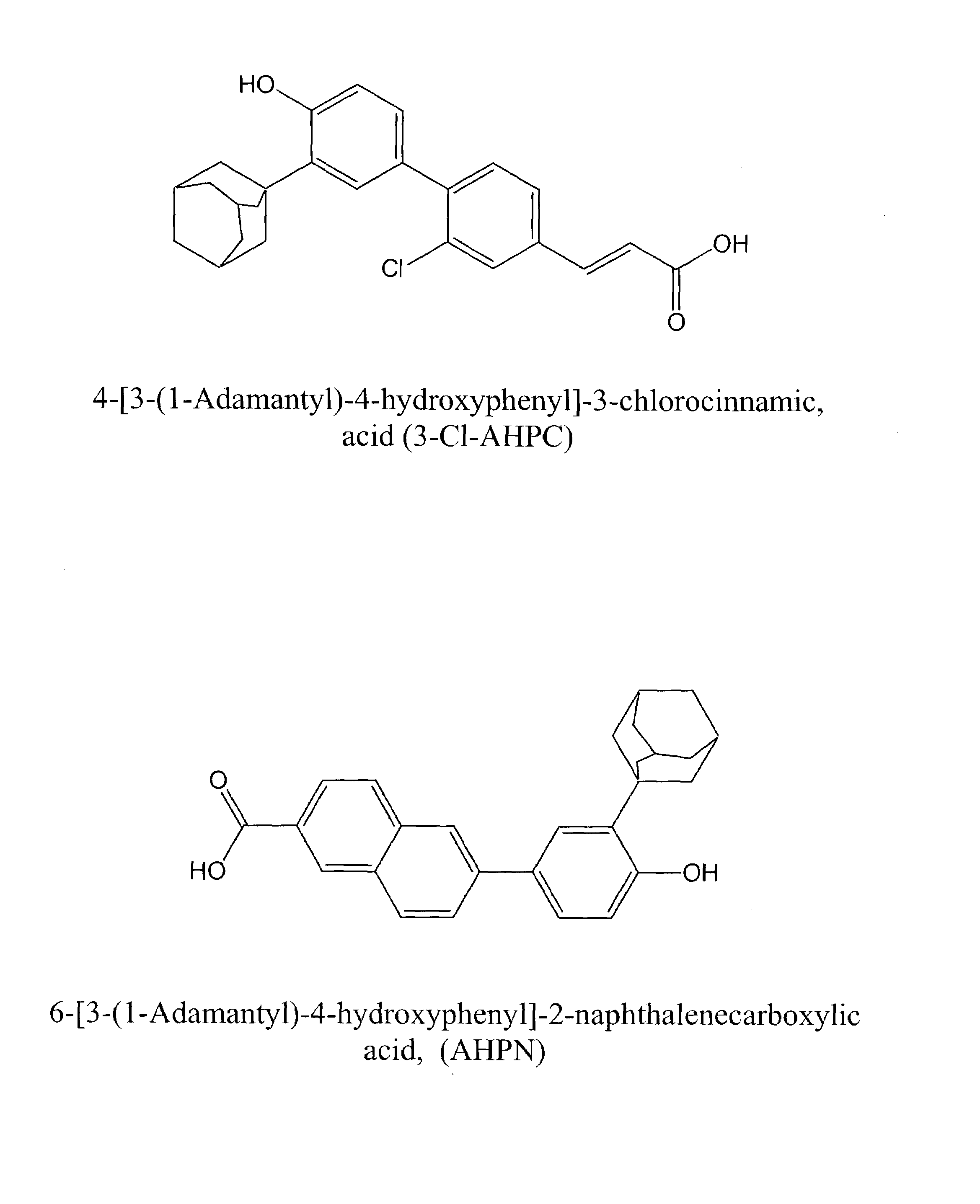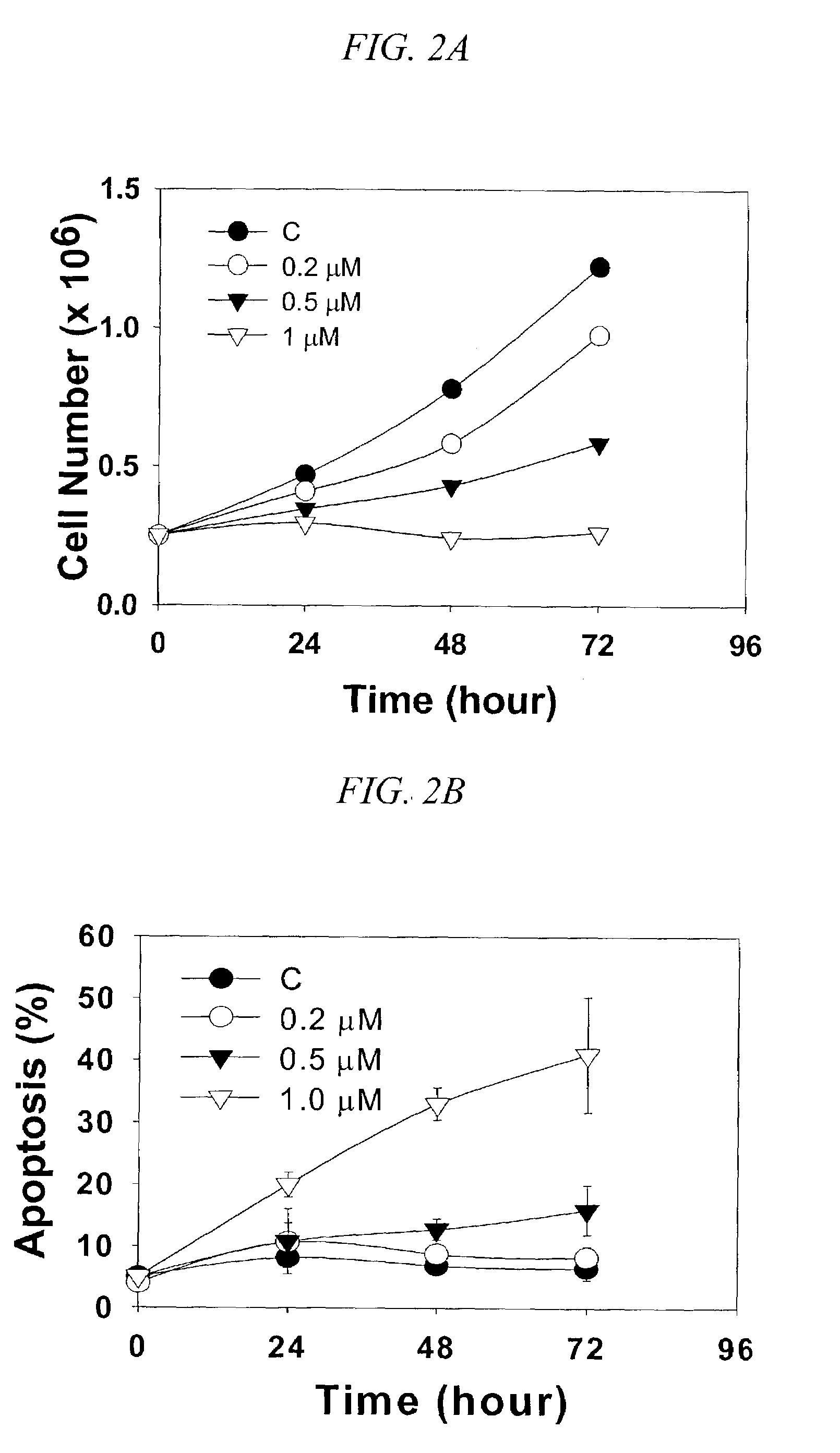Induction of apoptosis in cancer cells
- Summary
- Abstract
- Description
- Claims
- Application Information
AI Technical Summary
Benefits of technology
Problems solved by technology
Method used
Image
Examples
example 1
(E)-4-[3-(1-Adamantyl)-4-hydroxyphenyl]-3-chlorocinnamic acid (3-Cl-AHPC)
[0123]The synthesis of 3-Cl-AHPC was accomplished in seven steps as follows. Unless noted, the work-ups included extraction into ethyl acetate, washing (water, followed by saturated brine), drying (MgSO4), concentration, and, if necessary, flash column chromatography on silica gel.
Step 1: 4-Acetoxy-3-chlorobenzaldehyde. Step 1: 4-Acetoxy-3-chlorobenzaldehyde.
[0124]To 3-chloro-4-hydroxybenzaldehyde (5.00 g, 31.9 mmol) and pyridine (5.0 mL, 61.8 mmol) in dichloromethane (40 mL) at 0° C. was added acetic anhydride (4.0 mL, 42.3 mmol) over a 20-minute period. The mixture was stirred for 1.5 hours more, warmed to 20° C., then worked-up (10% hydrochloric acid wash) to afford 4-acetoxy-3-chlorobenzaldehyde as a pale-yellow solid (6.01 g, 92% yield): m.p. 33–35° C.; Rf0.30 (20% ethyl acetate / hexane); 1H NMR spectrum (400 MHz, CDCl3) δ 2.39 (s, 3, CH3), 7.34 (d, J=8.0 Hz, 1, ArH), 7.82 (dd, J=7.6,2 Hz, 1, ArH), 7.98 (d,...
example 2
Synthesis of (E)-4-[3-(1-Adamantyl)-4-hydroxyphenyl]-2-chlorocinnamic acid
Step 1: 4-Acetoxy-2-chlorobenzaldehyde.
[0131]A mixture of 2.43 g (15.5 mmol) of 2-chloro-4-hydroxybenzaldehyde and 5.0 ml (37.1 mmol) of pyridine in 40 ml of CH2Cl2 was stirred in a 0° C. ice bath, while 3.0 ml (31.8 mmol) of acetic anhydride was added over a period of 20 minutes. The reaction mixture was stirred for 1.5 hours more, then warmed to room temperature. The mixture was extracted with EtOAc, washed with 10% HCl, brine, and water, dried (MgSO4), filtered, and concentrated to afford a pale-yellow solid (2.98 g, 96% yield): m.p. 41–43° C.; Rf0.41 (20% EtOAc / hexane); 1H NMR (400 MHz, CDCl3) δ 2.33 (s, 3, CH3), 7.16 (dd, J=8.6, 2.0 Hz, 1, ArH), 7.28 (d, J=1.6 Hz, 1, ArH), 7.97 (d, J=8.8 Hz, 1, ArH), 10.42 ppm (s, 1, CHO).
Step 2: Ethyl (E)-4-acetoxy-2-chlorocinnamate.
[0132]To a suspension of 2.91 g (14.6 mmol) of 4-acetoxy-2-chlorobenzaldehyde and 6.00 g (43.4 mmol) of K2CO3 in 40 ml of anhydrous THF unde...
example 3
Synthesis of (E)-4-[3-(1-Adamantyl)-4-hydroxyphenyl]-3-methylcinnamic acid
Step 1: 4-Acetoxy-3-methylbenzaldehyde
[0138]A mixture of 5.20 g (38.2 mmol) of 4-hydroxy-3-methylbenzaldehyde, 5.0 ml (61.8 mmol) of pyridine in 40 ml of CH2Cl2 was stirred in a 0° C. ice bath, then 4.0 ml (42.3 mmol) of acetic anhydride was added over a period of 20 min. The reaction mixture was stirred for 1.5 hours more, then warmed to room temperature. The mixture was extracted with EtOAc, washed with 10% HCl, brine, and water, dried (MgSO4), filtered, and concentrated to afford a yellowish oil (6.51 g, 95% yield): Rf0.28 (20% EtOAc / hexane); 1H NMR (400 MHz, CDCl3) δ 2.27 (s, 3, CH3), 2.36 (s, 3, CH3), 7.20 (d, J=7.6 Hz, 1, ArH), 7.75 (dd, J=7.8,1.6 Hz, 1, ArH), 7.78 (s, 1, ArH), 9.96 ppm (s, 1, CHO).
Step 2: Ethyl (E)-4-acetoxy-3-methylcinnamate.
[0139]To a suspension of 6.37 g (35.7 mmol) of 4-acetoxy-3-methylbenzaldehyde and 15.00 g (108.5 mmol) of K2CO3 in 40 ml of anhydrous THF under Ar, 16.0 ml (71.3 m...
PUM
| Property | Measurement | Unit |
|---|---|---|
| Molar density | aaaaa | aaaaa |
| Fraction | aaaaa | aaaaa |
| Fraction | aaaaa | aaaaa |
Abstract
Description
Claims
Application Information
 Login to View More
Login to View More - R&D
- Intellectual Property
- Life Sciences
- Materials
- Tech Scout
- Unparalleled Data Quality
- Higher Quality Content
- 60% Fewer Hallucinations
Browse by: Latest US Patents, China's latest patents, Technical Efficacy Thesaurus, Application Domain, Technology Topic, Popular Technical Reports.
© 2025 PatSnap. All rights reserved.Legal|Privacy policy|Modern Slavery Act Transparency Statement|Sitemap|About US| Contact US: help@patsnap.com



